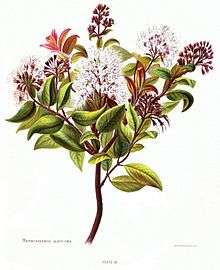Metrosideros albiflora
Metrosideros albiflora, also known as large white rātā, Northland white rātā, akatea[2] or simply white rātā, is a forest liane or vine endemic to New Zealand. It is one of three white flowering rātā vines (the others being white rātā and small white rātā). The name "albiflora" indeed literally means white flowered.[3] Despite the similar names, large white rātā is distinguished by its much larger leaves and flowers. Its flowers are amongst the largest of any rātā, similar in size to both scarlet rātā and pōhutukawa.[4] It occurs almost exclusively in Kauri forests from the northern Kaimai Ranges to Te Paki at the top of the North Island.[3]
| Large white rātā | |
|---|---|
 | |
| Scientific classification | |
| Kingdom: | Plantae |
| Clade: | Tracheophytes |
| Clade: | Angiosperms |
| Clade: | Eudicots |
| Clade: | Rosids |
| Order: | Myrtales |
| Family: | Myrtaceae |
| Genus: | Metrosideros |
| Species: | M. albiflora |
| Binomial name | |
| Metrosideros albiflora | |
| Synonyms[1] | |
| |
Description
The flowers of M. albiflora are a pure white, with flowering between October and March. Leaves grow up to 9 cm long and are leathery, and the vine can grow up to 10m high. If no support is available, it will instead form a large bush, and example of this can be seen in Waima, Northland in regenerating bush.[5]
Conservation
As of 2012, M. albiflora is not regarded as threatened.[3]
Cultivation
Metrosideros albiflora has a reputation for being exacting[4] and difficult[3] and is not common in cultivation. It is however available form specialist plant nurseries.[6][7] In addition to the large white flowers, its new foliage is a reddish colour. It strongly prefers a situation where its base is afforded shade and it is not permitted to dry out excessively.[4]
There is one known cultivar of large white rātā, Metrosideros albiflora 'Northland', which is listed in the Blue Mountain Nurseries catalog.[8]
References
- "The Plant List: A Working List of All Plant Species". Retrieved 21 February 2015.
- "akatea". Māori Dictionary. Retrieved 11 March 2015.
- "Metrosideros albiflora". www.nzpcn.org.nz. New Zealand Plant Conservation Network. Retrieved 21 December 2014.
- "Plant profiles > Metrosideros". www.o2landscapes.com/. O2 Landscapes. Retrieved 21 December 2014.
- Dawson, Murray; Hobbs, Jack; Platt, Graeme; Rumbal, Jim (2010). "Metrosideros in cultivation: Rata and other species" (PDF). New Zealand Garden Journal. 13 (2): 10–23. Retrieved 21 December 2014.
- "Metrosideros albiflora". www.oratianatives.co.nz. Oratia Native Plant Nursery. Retrieved 21 December 2014.
- "Naturally Native's Online Plant Catalogue". www.naturallynative.co.nz/. Naturally Native. Retrieved 21 December 2014.
- "Blue Mountain Nursery catalog". Blue Mountain Nurseries. Blue Mountain Nursery. Archived from the original on 21 December 2014. Retrieved 21 December 2014.
Further reading
- Salmon, J.T., 1986. The Native Trees of New Zealand. Wellington: Heinneman Reed.
- Simpson, P., 2005. Pōhutukawa & Rātā: New Zealand's Iron-Hearted Trees. Wellington: Te Papa Press.